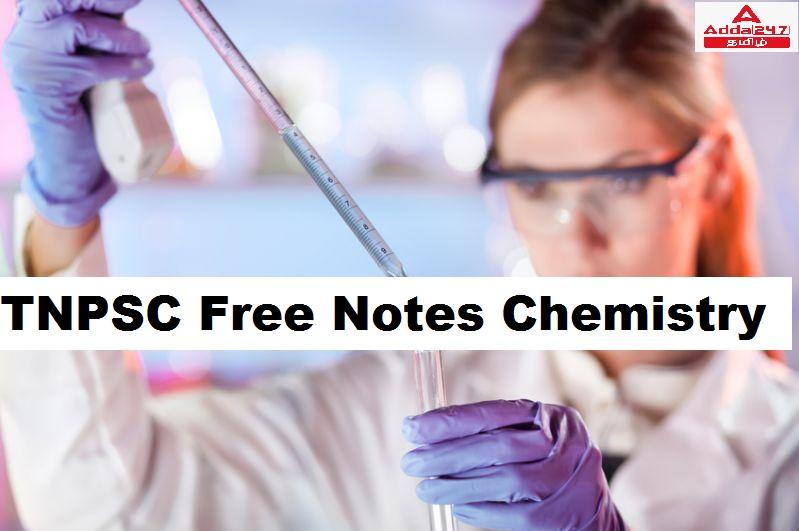இந்தக் கட்டுரையில், TNPSC குரூப் 1, குரூப் 2, குரூப் 2A, குரூப் 4 மாநிலப் போட்டித் தேர்வுகளான TNUSRB, TRB, TET, TNEB போன்றவற்றுக்கான முறைகள் இலவசக் குறிப்புகளைப் பெறுவீர்கள்.தேர்வுக்கு தயாராவோர் இங்குள்ள பாடக்குறிப்புகளை படித்து பயன்பெற வாழ்த்துகிறோம்.
Chemical properties of Acids, Base and Salt
Chemical Properties of Acids
Metals with Acids
Metal + Acid → Salt + Hydrogen
Ag, Cu Do not liberate Hydrogen
Mg + H 2 SO 4 MgSO 4 + H 2
Metal Carbonate (or) Metal bicarbonate with Acids
Metal carbonate (or) Metal bicarbonate + Acid → Salt + Water + Carbon dioxide
MgCO 3 + 2HCl → MgCl 2 + H 2 O + CO 2
Mg(HCO 3 ) + 2HCl → MgCl 2 + 2H 2 O + 2CO 2
Metallic oxides with Acids
Metallic Oxide + Acid → Salt + Water
CaO + 2HCl → CaCl 2 + H 2 O
Water with Acids
Acid + Water →Hydrogen ion+
HCl + H 2 O → H 3 O + + Cl –
Chemical Properties of Base
Metals with base
Metal + Base → Salt + Hydrogen
Zn + 2NaOH → Na2 ZnO2 + H2↑ [Sodium Zincate]
Non – Metallic oxides with Base
Non-Metallic Oxides + Bases → Salt + Water
2NaOH + CO2 → Na2CO3 + H2O [Sodium Carbonate]
Water with Base
Base + Water → Hydroxide ions
NaOH – Do not react with Cu, Ag, Cr
NaOH → Na+ + OH-
Acid + Base → Salt + Water
HCl + NaOH → NaCl + H 2 O
Uses of Acids
H 2 SO 4 – Car Batteries
HNO 3 – Fertilizer
HCl – Cleansing toilets
C 4 H 6 O 6 – Tartaric acid – Baking Powder
H 2 CO 3 – carbonic acid – Aerated drinks
C 7 H 6 O 2 – Benzoic Acid – Food Preservative
Uses of Base
NaOH – Soap manufacturing
Ca(OH) 2 – White Washing
Mg(OH) 2 – Medicine For Stomach Disorder
NH 4 OH – Removal of Grease from cloths
Salt
Characteristics of Salts
Acid + Base → Salt + Water + Heat [Neutralization]
Mostly Solids
Soluble in Water (Exception: Silver Chloride)
Odourless
Hygroscopic Nature
Identification of Salts
Physical Examination
Dry Heating Test
Flame Test
Flame Test
Salt + HCl Paste is heated with help of Platinum Wire
Classification of Salts
Normal Salt
A normal salt is obtained bycomplete neutralization of an acid by a base.
NaOH + HCl → NaCl + H 2 O
Acid Salt
It is derived from the partialreplacement of hydrogen ions of an acidby a metal. When a
calculated amount of a base is added to a polybasic acid, acid salt is obtained.
NaOH + H 2 SO 4 → NaHSO 4 +H 2 O
Basic Salt
Basic salts are formed by the partial replacement of hydroxide ions of adiacidic or
triacidic base with an acid radical.
Pb(OH 2 ) + HCl → Pb(OH)Cl +H 2 O
Double Salt
Double salts are formed by the combination of the saturated solution of twosimple salts
in equimolar ratio followed by crystallization.
Simple Salt + Simple Salt → Double Salt
E.g. Potash AlumKAl(SO 4 ) 2 .12H 2 O
Uses of Salts
Common Salt (NaCl)
o Food Préservative
Washing Soda (Na 2 CO 3 )
o Softening Hard Water
o Cleaning Agent for Domestic Purposes
Baking Soda (NaHCO 3 )
o Making of Baking Powder
o Neutralizes Acidity in Stomach
Bleaching Powder (CaOCl 2 )
o Disinfecting drinking water free from micro organism
o To bleach cotton & linen
Plaster of Paris (CaSO 4 . ½ H 2 O)
o Plastering fractured bones
o Making casts for statues
Gypsum Salt (CaSO 4 . 2H 2 O)
o Making Fertilizer
o Making Cements
Epsom Salt (MgSO 4 . 7H 2 O)
o Medicine for Stomach Disorder
**************************************************************************
| Adda247 TamilNadu Home page | Click here |
| Official Website=Adda247 | Click here |









